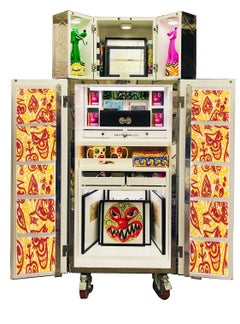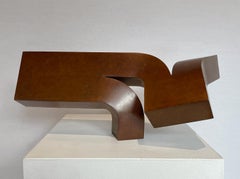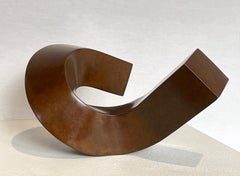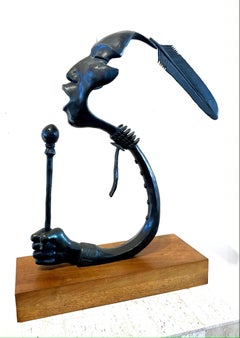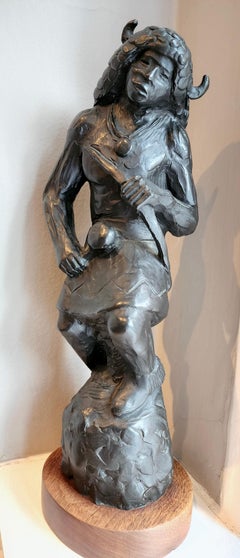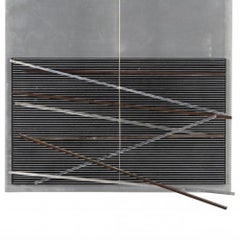20th Century Abstract Sculptures
to
134
680
203
159
75
262
Overall Width
to
Overall Height
to
4
11
1,379
8,113
2
2
7
10
11
41
123
204
273
230
466
202
196
28
24
23
22
19
6
3
13
7
6
6
5
5
5
4
4
4
4
3
3
2
1
1
1
1
1
1
771
342
261
172
167
49
24
14
12
11
1
1,030
284
Period: 20th Century
Kosmic Cabinet
Located in Santa Monica, CA
Included: one original KS Icon Drawing. Cabinet 01. 3 styles of Tondo Mugs and 4 Hedz Mugs all sold out. NewTondo stickers first edition of 14, 10 on inner Kabinet doors as plaques and 4 on white lacquer tray. Assorted KS books and early white pages book.1990 KS for Kambly Tin. With reproduction personal photographs inside.
Cateyeguy 2004 edition of 2500. Dogeyeguy with original packaging 2004 edition of 2500. Vintage KS deck of cards. New in Box KS zippo 1993 # 75 of 999. KS Lido Paris...
Category
Assemblage 20th Century Abstract Sculptures
Materials
Mixed Media
Price Upon Request
"Offshoot" minimalist bronze sculpture
Located in Glen Ellen, CA
"Offshoot" is a horizontal pedestal sculpture by renowned Australian artist Clement Meadmore. It is an elegantly simple form with a beautiful dark brown patina. "Offshoot" balances o...
Category
Minimalist 20th Century Abstract Sculptures
Materials
Bronze
Price Upon Request
"Swing" minimalist bronze sculpture
Located in Glen Ellen, CA
"Swing" is a minimalist abstract sculpture in fabricated bronze that was conceived in 1969 and can be considered a Mid-Century Modern artwork. It is finished with Clement Meadmore's ...
Category
Minimalist 20th Century Abstract Sculptures
Materials
Bronze
Price Upon Request
Lead Singer, bronze, sculpture, Allan Houser, Native American, Drummer, Apache
By Allan Houser
Located in Santa Fe, NM
Lead Singer, bronze, sculpture, Allan Houser, Native American, Drummer, Apache
Allan Houser Haozous Warm Springs Chiricahua Apache 1914-1994 National Medal of Arts awardee Allan Houser (Haozous), Chiricahua Apache (1914-1994) Selected Collections Centre Georges Pompidou, Paris, France * “They’re Coming”, bronze Dahlem Museum, Berlin, Germany Japanese Royal Collection, Tokyo, Japan “The Eagle”, black marble commissioned by President William J. Clinton United States Mission to the United Nations, New York City, NY *"Offering of the Sacred Pipe”, monumental bronze by Allan Houser © 1979 Presented to the United States Mission to the United Nations as a symbol of World Peace honoring the native people of all tribes in these United States of America on February 27, 1985 by the families of Allan and Anna Marie Houser, George and Thelma Green and Glenn and Sandy Green in New York City. National Portrait Gallery, Smithsonian, Washington, DC * Portrait of Geronimo, bronze National Museum of American Art, Smithsonian, Washington, D.C. * “Buffalo Dance Relief”, Indiana limestone National Museum of the American Indian, Smithsonian, Washington, D.C. *Sacred Rain Arrow, (Originally dedicated at the US Senate Committee on Indian Affairs, US Senate Building) “Goat”, “To The Great Spirit” - dedicated in 1994 at the Vice President’s Residence in Washington, D.C.. Ceremony officiated by Hillary Rodham Clinton and Tipper Gore. Oklahoma State Capitol, Oklahoma City, Ok * “As Long As the Waters Flow”, bronze Gilcrease Museum, Tulsa, OK *Sacred Rain Arrow, bronze Fort Sill, Oklahoma *”Chiricahua Apache Family”, bronze Donated and dedicated to Allan Houser’s parents Sam and Blossom Haozous by Allan Houser and Glenn and Sandy Green The Heard Museum, Phoenix, Arizona *Earth Song, marble donated by Glenn and Sandy Green The Clinton Presidential Library, Arkansas * “May We Have Peace”, bronze The George H.W. Bush Presidential Library, College Station, Texas *"Offering to the Great Spirit", bronze The British Royal Collection, London, England *Princess Anne received "Proud Mother", bronze in Santa Fe Allan Houser’s father Sam Haozous, surrendered at the age of 14 with Geronimo and his band of Warm Springs Chiricahua Apache people in 1886 in Southern Arizona. This was the last active war party in the United States. This group of Apache people was imprisoned for 27 years starting in Fort Marion, Florida and finally living in captivity in Fort Sill, Oklahoma. Allan Houser was born in 1914. His artwork is an ongoing testimony to Native life in America – its beauty, strength and poignancy. Allan Houser is from the culture and portrayed his people in an insightful and authentic way. Because of the era in which he lived, he had a rare understanding of American Indian life. Allan was the first child born after the Chiricahua Apaches were released from 27 years of captivity. Allan grew up speaking the Chiricahua dialect. Allan heard his father’s stories of being on the warpath with Geronimo and almost nightly heard his parents singing traditional Apache music. Allan’s father knew all of Geronimo’s medicine songs. Allan had an early inclination to be artistic. He was exposed to many Apache ceremonial art forms: music, musical instruments, special dress, beadwork, body painting and dynamic dance that are integral aspects of his culture. His neighbors were members of many different tribes who lived in Oklahoma. Allan eagerly gained information about them and their cultures. Allan gathered this information and mentally stored images until he brought them back to life, years later, as a mature artist. Allan Houser was represented by Glenn Green Galleries (formerly known as The Gallery Wall, Inc.) from 1973 until his death in 1994. The gallery served as agents, advocates, and investors during this time. In 1973 the Greens responded enthusiastically to the abstraction and creativity in Houser’s work. They were impressed, not only with his versatility and talent but with the number of mediums he employed. His subject matter was portrayed in styles ranging from realism, stylized form to abstraction. With encouragement from the Greens, Houser at the age of 61, retired from his post as the head of the sculpture department at the Institute of American Indian Arts in Santa Fe, New Mexico in 1975 to begin working full-time creating his art. The next 20-year period was an exciting time for Allan, the gallery, and for the Green family. He created a large body of sculpture in stone, wood and bronze. For many years Glenn Green Galleries co-sponsored many editions of his bronzes and acted as quality control for the bronze sculptures according to Houser’s wishes. As both agents and gallery representatives, the Greens promoted and sold his art in their galleries in Phoenix and Scottsdale, Arizona and in Santa Fe, New Mexico. They had bi-annual exhibits in their galleries to feature Houser’s newest work and sponsored and arranged international museum shows in America, Europe and Asia. They travelled for these events including a trip to Carrara, Italy to the famed quarries of Michelangelo and together co-financed and arranged the purchase of 20 tons of marble. A watershed event for Allan Houser’s career occurred in the early 1980’s when Glenn Green Galleries arranged with the US Information Agency a touring exhibit of his sculpture through Europe. This series of exhibits drew record attendance for these museums and exposed Houser’s work to an enthusiastic art audience. This resulted in changing the perception of contemporary Native art in the United States where Houser and Glenn Green Galleries initially faced resistance from institutions who wanted to categorize him in a regional way. The credits from the European exhibits helped open doors and minds of the mainstream art community in the United States and beyond. Senator Daniel Inouye of Hawaii was a supporter of Allan Houser’s artwork. We worked with Senator Inouye on many occasions hosting events at our gallery and in Washington D.C in support of the formation of the Smithsonian’s National Museum of the American Indian in Washington, D.C. and other causes supporting Native Americans. Allan Houser is shown below presenting his sculpture “Swift Messenger” to Senator Inouye in Washington, D.C.. This sculpture was eventually given to the National Museum of the American Indian, Smithsonian’s permanent collection. It is now currently on loan and on display in the Oval Office. President Biden’s selection of artwork continues our gallery’s and Allan’s connection to the White House from our time working with Allan Houser from 1974 until his passing in 1994. “It was important for President Biden to walk into an Oval that looked like America and started to show the landscape of who he is going to be as president,” Ashley Williams...
Category
Contemporary 20th Century Abstract Sculptures
Materials
Bronze
Buffalo Dance, bronze, sculpture, by Allan Houser, brown, casting, Pueblo
Located in Santa Fe, NM
Buffalo Dance, bronze, sculpture, by Allan Houser, brown, casting, Pueblo,dancer
limited edition bronze casting of 20
lifetime casting
Category
Contemporary 20th Century Abstract Sculptures
Materials
Bronze
Vibrations Metalliques
Located in Miami, FL
TECHNICAL INFORMATION:
Jesus Rafael Soto (June 5, 1923 - January 14, 2005, Venezuelan)
Vibrations Metalliques
1969
painted metal with metal rod with nylon string
10 3/4 x 11 3/4 x 5...
Category
Kinetic 20th Century Abstract Sculptures
Materials
Metal
Price Upon Request
Basket
By Ken Ferguson
Located in Missouri, MO
Basket By Ken Ferguson (1928-2004)
21" x 13"
Ken Ferguson received an M.F.A. in 1954 from Alfred University, and went on to become an influential teacher and artist in his field of pottery. From 1964 until 1996, when he was named Professor Emeritus, Ferguson was Head of the Ceramics Department at the Kansas City Art Institute.
His students included Kurt Weiser...
Category
Abstract 20th Century Abstract Sculptures
Materials
Earthenware, Glaze
Price Upon Request
Edgar Negret Mascara, 1994, Painted Aluminum, 87 x 87 x 32 cm
Located in Miami, FL
Edgar Negret
Mascara, 1994
Painted Aluminum
87 x 87 x 32 cm
34.2 x 34.2 x 12.5 in.
The artwork is signed and dated on the back and illustrated as follows...
Category
Abstract Geometric 20th Century Abstract Sculptures
Materials
Metal
Edgar Negret El Sol Rojo, 1985, Painted Aluminum, 250 x 244 x 80 cm
Located in Miami, FL
Edgar Negret
El Sol Rojo, 1985
Painted Aluminum
250 x 244 x 80 cm
98.4 x 96.1 x 31.5 in.
Carlos Jiménez Moreno, Negret Escultor: Homenaje. Villegas Edito...
Category
Abstract Geometric 20th Century Abstract Sculptures
Materials
Metal
Primavera
Located in West Hollywood, CA
We are proud to present an original very early bronze, (1958) by American sculptor Robert Russin.
Robert Russin began his career as a WPA sculptor, and received dozens of commission...
Category
Cubist 20th Century Abstract Sculptures
Materials
Bronze
Price Upon Request
Untitled
Located in New York, NY
Beverly Pepper
Untitled, 1982-1983
steel and iron
33h x 27.50w x 10d in
Category
Abstract 20th Century Abstract Sculptures
Materials
Steel, Iron
Price Upon Request
"Petit masque découpé Montserrat", 20th Century Bronze by Julio González
Located in Madrid, ES
JULIO GONZÁLEZ
Spanish, 1876 - 1942
PETIT MASQUE DÉCOUPÉ MONTSERRAT
signed "GONZALEZ"
5 of an edition of 9
Cire Perdue "C. VALSUANI" foundry seal
bronze...
Category
Cubist 20th Century Abstract Sculptures
Materials
Bronze
Desert Breeze, Sculpture by Allan Houser Haozous, Bronze, Cloaked Figures
By Allan Houser
Located in Santa Fe, NM
Desert Breeze, Sculpture by Allan Houser Haozous, Bronze, Cloaked Figures,Apache
Allan Houser was represented by Glenn Green Galleries (formerly known a...
Category
Contemporary 20th Century Abstract Sculptures
Materials
Bronze
Pedro Barreto, Esfera, Marble, ø 25.6 in. ø 65 cm
Located in Miami, FL
Pedro Barreto
Esfera, Undated
Marble
ø 25.6 in. ø 65 cm (Depth 5.9 in. 15 cm)
Base: 7.9 x 7.9 x 9.8 in. 20 x 20 x 25 cm
Pedro Barreto (b. Santa Catalina, Venezuela, 1935; d. Lechería, Venezuela, 2008)
His first experiences as a sculptor were with wood, influenced by his place of birth in the Orinoco River delta.
Between 1954 and 1958, he studies at the Plastic and Applied Arts School of Caracas.
In 1957, his first one-man exhibition took place in Tucupita, earning him a scholarship to study in Europe.
He attends the School of Fine Arts of Rome until 1960, after which he travels to Paris and works in Agustín Cárdenas’ studio.
In 1973, he is awarded Tokyo’s Shinsakasho Prize and Venezuela’s Salón Arturo Michelena.
Category
Abstract 20th Century Abstract Sculptures
Materials
Marble
Price Upon Request
Jesús Rafael Soto, Quadrato, 1974, Edition Denise René. Ed. 32/75
Located in Miami, FL
Jesús Rafael Soto
Quadrato 1974
Edition Denise René. Ed. 32/75
Acrylic on aluminum with painted metal rods
45.7 x 40 x 32 cm
17.9 x 15.7 x 12.5 in.
Jesús Rafael Soto (1923 - 2005) ...
Category
Kinetic 20th Century Abstract Sculptures
Materials
Mixed Media
The Duck (N.6., No. 3)
By Garth Evans
Located in Austin, TX
Artist: Garth Evans (British, b. 1934)
Title: "The Duck (N.6., No. 3)"
Year: 1982
Medium: Painted plywood wall-hanging sculpture
Signed and titled
Dimensions: 24" x 12" x 7"
Conditio...
Category
Contemporary 20th Century Abstract Sculptures
Materials
Plywood, Acrylic
Price Upon Request
"Tornado" Large-Scale, Abstract Metal Sculpture in steel by Joel Perlman
By Joel Perlman
Located in New York, NY
"Tornado" by Joel Perlman
Abstract Metal Sculpture in steel
Joel Perlman has been creating complex sculptures out of steel, bronze, and aluminum since the early 1970's. While minimalism was the predominant style of his genration, Perlman chose to push his forms into ever-more complicated, gravity defying, configurations. Perlman investigates with originality. He expands, rather than appropriates, enriching our experience with industrial materials.
Contemporary, Abstract Outdoor Metal...
Category
Abstract 20th Century Abstract Sculptures
Materials
Metal, Steel
Entwined Bodies, Bronze Sculpture by Sophia Vari
By Sophia Vari
Located in Long Island City, NY
Artist: Sophia Vari, Greek (1940 - )
Title: Entwined Bodies
Year: circa 1985
Medium: Bronze Sculpture, Signature and number inscribed with foundry stamp
Edition: 4/6
Size: 12.5 x 2...
Category
Modern 20th Century Abstract Sculptures
Materials
Bronze
Price Upon Request
Man Losing his Head and Hat
By Allen Jones
Located in Zug, CH
A Unique sculpture by Allen Jones, one of the very few variations on the theme, made in a forge and painted differently then other variations on the theme.
Category
Abstract 20th Century Abstract Sculptures
Materials
Steel
Price Upon Request
Lilith [Orange], Bronze
Located in San Francisco, CA
"Lilith" is a bronze sculpture by Paul Braslow. This sculpture is hand-signed.
He was an American sculptor and artist that established himself in the me...
Category
Contemporary 20th Century Abstract Sculptures
Materials
Bronze, Enamel
Price Upon Request
"Jazz on a T-" Abstract Kinetic Sculpture
By John Scott
Located in Houston, TX
Vibrant kinetic sculpture that includes a base that can be mounted on the wall with long pole-like attachment that balances at the base of the piece. The work is wonderfully painted in a variety of vibrant colors and patterns.
Artist Biography: Artist John Scott was born in New Orleans and raised in the city’s Lower Ninth Ward. He taught at Xavier University for more than 40 years and was named a MacArthur Fellow in 1992 by the John D. and Catherine T. MacArthur Foundation, a highly prestigious honor that came at the height of his career.
Scott was known for creating vibrant kinetic sculptures that explored topics ranging from the West African diddly-bow string instrument to the rhythms and movements inspired by enslaved dancers in early 19th-century in New Orleans’s famed Congo Square. His large woodcuts...
Category
Abstract 20th Century Abstract Sculptures
Materials
Metal
Price Upon Request
Piccolo Guerriero (Little Warrior)
Located in Missouri, MO
Luciano Minguzzi (Italian, 1911-2004)
Piccolo Guerriero (Little Warrior) c. 1950s
Bronze
Monogrammed and Numbered 1/5
Height From Base to Top: approx. 12" High
Bronze: 6 3/4 inches x 4W x 3D
Luciano Minguzzi was born in Bologna in 1911 and died in Milan in 2004. In 1943 he took part in the Fourth Quadrennial of Rome. In 1950 he was awarded the grand prize for sculpture at the XXV Venice Biennale, and attended again in 1952.
His works can be found at Museum of the Fabbrica del Duomo, in the Museum of Modern Art in the Vatican and in the Galleries of Modern Art in Rome, Milan, Bologna, Florence, Trieste, Verona, Carrara, Padova, as well as abroad and overseas.
Additional Biography (translated from Italian):
Luciano Minguzzi ( Bologna , 24 May 1911 - Milan , 30 May 2004 ) was a sculptor and medalist Italian .
Image of the exhibition Luciano Minguzzi: sculptures and gouaches 1950-1970 in the Romanesque cloister of the Cathedral of Prato ( Museo dell'Opera del Duomo ), 24 April - 24 May 1971. Photo by Paolo Monti .
Index:
He made his first experiences under the wise guidance of his father, also a sculptor , continuing his studies at the Academy of Fine Arts in Bologna following the engraving courses held by Giorgio Morandi , those of sculpture under the guidance of Ercole Drei , attending at ' university the lessons Roberto Longhi.
Thanks to a scholarship, he stayed in Paris and London , starting to exhibit in 1933 and already at the Roman Quadrennial of 1943 he obtained his first prize, which was followed by others including the Angelicum of 1946 and the first place ex aequo at the Biennale del 1950.
Immediately after the war he created the monument to the Partisan and the Partisan for his hometown , located near Porta Lame , in the area where an epic battle between Nazi-Fascists and partisans took place in 1944 .
The work, composed of two figures of young people - one of which armed - caught in a moment of great naturalness, was forged with cast bronze from the equestrian statue of Benito Mussolini (by Giuseppe Graziosi ) which was located inside the current "Renato Dall'Ara" Stadium, in turn made with some cannons stolen from the Austrians during the Bolognese Risorgimento uprisings of 1848.
Still on the theme linked to war , but with a changed style with more dramatic and expressionist tones , in the fifties he created a series of sculptures inspired by the theme of the men of the Lager and the unknown and anonymous victims, obtaining in 1953 the third prize in the competition for the "Monument to the Unknown Political Prisoner " announced by the Tate Gallery ( London ).
In 1950 he won the competition for the "Quinta Porta" of the Milan Cathedral , completed in 1965 .
In 1962 he participated, together with the most important international sculptors of the time, in the exhibition Sculptures in the city organized by Giovanni Carandente as part of the V Festival dei Due Mondi in Spoleto . He presented a 1958 iron and bronze sculpture entitled Pas-de-quatre.
In 1970 he was given the task of building the "Door of good and evil" of the basilica of St. Peter in the Vatican , on which he worked with vigor and passion for seven years.
In 2012, on the occasion of the centenary of the artist's birth, a posthumous anthological exhibition was set up in Bologna at the Fondazione del Monte [1] .
He also worked as a medalist: his example is the silver 500 lire coin...
Category
Modern 20th Century Abstract Sculptures
Materials
Bronze
Price Upon Request
Untitled Figure with X on Chest by Charlie Willeto, Navajo Folk Art, wood, paint
Located in Santa Fe, NM
Untitled Figure with X on Chest by Charlie Willeto, Navajo Folk Art, wood, paint
Vintage
Category
Folk Art 20th Century Abstract Sculptures
Materials
Wood, Paint
Herodias
Located in Greenwich, CT
Signed and dated 1952 and numbered 3/10 on the back. This sculpture was included in a 1966 exhibition of Nakian's work at the Museum of Modern Art, NYC.
Reuben Nakian, born August ...
Category
Abstract 20th Century Abstract Sculptures
Materials
Bronze
Price Upon Request
Platter
Located in Kansas City, MO
Artist : Arnie Zimmerman
Title : Platter
Materials : Stoneware, glaze
Date : 1982
Dimensions : 22.75" x 23.5" x 4.5"
Description : Hand-signed and dated o...
Category
Modern 20th Century Abstract Sculptures
Materials
Ceramic, Glaze, Stoneware
Price Upon Request
Column, Unique Carved Marble and Stone Column Sculpture by Emile Gilioli
Located in Long Island City, NY
Artist: Emile Gilioli, French (1911 - 1977)
Title: Column
Year: circa 1960
Medium: Carved and Painted Marble on Marble Base, Signature Incised Verso
Size: 65.5 in. x 31 in. x 8 in. (...
Category
Modern 20th Century Abstract Sculptures
Materials
Marble
"Scoop" Abstract, Metal Chain Link Sculpture by John Ruppert
By John Ruppert
Located in New York, NY
"Scoop" by John Ruppert
Galvanized chain link fabric, stainless steel
Over the past 35 years, John Ruppert has been working in cast metals; manufactured ...
Category
Abstract 20th Century Abstract Sculptures
Materials
Metal, Stainless Steel
Gree's Head
By Sophia Vari
Located in Long Island City, NY
Artist: Sophia Vari, Greek (1940 - )
Title: Gree's Head
Year: 1985
Medium: Bronze Sculpture, Signature and number inscribed with foundry stamp
Edition: 1/6
Size: 7.25 x 7 x 6 in....
Category
Modern 20th Century Abstract Sculptures
Materials
Bronze
Price Upon Request
Cororeol, Polished Bronze Sculpture by Antoine Poncet
Located in Long Island City, NY
Artist: Antoine Poncet, Swiss (1928 - )
Title: Cororeol
Medium: Polished Bronze Sculpture, Signature 'A.P.' inscribed
Edition: 2/6
Size: 41 in. x 21 in. x 5 in. (104.14 cm x 53.34 cm...
Category
Abstract 20th Century Abstract Sculptures
Materials
Bronze
Price Upon Request
U.S.A., Neon Light Box Sculpture by Chryssa, 1962
Located in Long Island City, NY
This is a unique neon sculpture in plexi-box with stand. It is the very first completed Neon Sculpture by the famed sculptor and referenced in the monograph "Chryssa" by Pierre Restany. Chryssa, a Greek-born American sculptor who in the 1960s was one of the first people to transform neon lighting from an advertising vehicle into a fine art medium. A builder of large-scale assemblages in a wide range of materials — bronze, aluminum, plaster, wood, canvas, paint, found objects and, in the case of neon, light itself — Chryssa, whose work prefigured Minimalism and Pop Art, was considered a significant presence on the American art scene in the ’60s and ’70s. Exhibited widely in the United States in those years, her art is in the collections of major museums, including the Museum of Modern Art, the Guggenheim Museum and the Whitney Museum of American Art in New York, and the Corcoran Gallery of Art in Washington.
Artist: Chryssa, Greek (1933 - 2013)
Title: USA, First Preparartory Work For a Neon Box...
Category
Contemporary 20th Century Abstract Sculptures
Materials
Plexiglass, Neon Light
Peace
By Heloise Crista
Located in Missouri, MO
Heloise Crista (1926-2018)
Peace
Brass and Copper
approx. 15 x 17 x 10 inches
Heloise Crista, Acclaimed Sculptor and Frank Lloyd Wright Apprentice
FRANK LLOYD WRIGHT FOUNDATION JU...
Category
American Modern 20th Century Abstract Sculptures
Materials
Brass, Copper
Price Upon Request
Jealousy, bronze edition sculpture of a man with two women, Eduardo Oropeza
Located in Santa Fe, NM
Jealousy, bronze edition sculpture of a man with two women, Eduardo Oropeza
Jealousy, bronze and straw sculpture of a man with two women
edition of 12
Category
Contemporary 20th Century Abstract Sculptures
Materials
Bronze
Jealousy, bronze twigs edition sculpture of man with two women, Eduardo Oropeza
Located in Santa Fe, NM
Jealousy, bronze edition sculpture of a man with two women, Eduardo Oropeza
Jealousy, bronze and straw sculpture of a man with two women
edition of 12
Category
Contemporary 20th Century Abstract Sculptures
Materials
Bronze
Plate CR952-W
Located in Kansas City, MO
Peter Voulkos
Title: Plate CR952-W
Medium: Woodfired ceramic
Year: 1989
Signed and dated by the artist
Size: approx. 20.5 x 5 inches
A West Coast potter and sculptor, Peter Voulkos (1924-2002) led in the development of pottery as an art form. . With an MFA from California College of Arts and Crafts (1952), he taught at Black Mountain College (1953) where he was exposed to the avant-garde. In 1954, Voulkos moved to Los Angeles to become the chairman of a newly established ceramics department at the Los Angeles County Art Institute (later renamed the Otis Art Institute) and soon assembled a remarkable group of students: Paul Soldner, Jerry Rothman, Kenneth Price, John Mason, Henry Takemoto...
Category
Post-Modern 20th Century Abstract Sculptures
Materials
Ceramic
Price Upon Request
Plate CR1056-W
Located in Kansas City, MO
Peter Voulkos
Title: Plate CR1056-W
Medium: Woodfired ceramic
Year: 1992
Signed and dated by the artist
Size: approx. 24 x 4.5 inches
A West Coast potter and sculptor, Peter Voulkos (1924-2002) led in the development of pottery as an art form. . With an MFA from California College of Arts and Crafts (1952), he taught at Black Mountain College (1953) where he was exposed to the avant-garde. In 1954, Voulkos moved to Los Angeles to become the chairman of a newly established ceramics department at the Los Angeles County Art Institute (later renamed the Otis Art Institute) and soon assembled a remarkable group of students: Paul Soldner, Jerry Rothman, Kenneth Price, John Mason, Henry Takemoto...
Category
Abstract Expressionist 20th Century Abstract Sculptures
Materials
Ceramic
Price Upon Request
Plate 1329-W
Located in Kansas City, MO
Peter Voulkos
Title: Plate 1329-W
Medium: Woodfired ceramic
Year: 1998
Signed and dated by the artist
Size: approx. 20.5 x 21 x 5.25 inches
A West Coast potter and sculptor, Peter V...
Category
American Modern 20th Century Abstract Sculptures
Materials
Ceramic
Price Upon Request
Plate CR1190-W
Located in Kansas City, MO
Peter Voulkos
Title: Plate CR1190-W
Medium: Woodfired ceramic
Year: 1995
Signed and dated by the artist
Size: approx. 19.5 x 20.5 x 5.75 inches
A West Coast potter and sculptor, Peter Voulkos (1924-2002) led in the development of pottery as an art form. . With an MFA from California College of Arts and Crafts (1952), he taught at Black Mountain College (1953) where he was exposed to the avant-garde. In 1954, Voulkos moved to Los Angeles to become the chairman of a newly established ceramics department at the Los Angeles County Art Institute (later renamed the Otis Art Institute) and soon assembled a remarkable group of students: Paul Soldner, Jerry Rothman, Kenneth Price, John Mason, Henry...
Category
Modern 20th Century Abstract Sculptures
Materials
Ceramic
Price Upon Request
White Marble Abstract Sculpture by Sergio Camargo
Located in Long Island City, NY
Artist: Sergio Camargo, Brazilian (1930 - 1990)
Medium: White Marble Sculpture, signature inscribed on base front
Size: 7.875 x 12.25 x 10.25 inches ; 2...
Category
Abstract Geometric 20th Century Abstract Sculptures
Materials
Marble
Wood Fired Platter
Located in Kansas City, MO
Wood Fired Platter
Material: Stoneware and woodfired
Year: 1989
Signed
Dimensions: 3 x 22 x 22"
Provenance - Charles Cowles Gallery, NYC
A West Coast potte...
Category
Abstract 20th Century Abstract Sculptures
Materials
Stoneware
Price Upon Request
Fish Pitcher
Located in Missouri, MO
Fish Pitcher 1952
Turned Pitcher
13 cm x 21 cm/approx 8 1/4 x 4 3/4 inches
Red Earthenware Clay, Decoration in Engobes
Black, White
Edition Madoura Picas...
Category
Abstract 20th Century Abstract Sculptures
Materials
Ceramic
Price Upon Request
Star of Peace
By Yaacov Agam
Located in Missouri, MO
Yaacov Agam
"Star of Peace" c. 1970s
Metal
Ed. 2/300
approx. 9 x 2 x 2 inches
Born in Israel on May 11, 1928. His father was a rabbi, a Talmudic scholar and a Kabbalist. The famil...
Category
Abstract 20th Century Abstract Sculptures
Materials
Metal
Price Upon Request
Square Wood Window Sculpture
By David Nash
Located in Houston, TX
Organic sculpture by famous sculptor David Nash of a tree trunk that has been shaped into a square with a concentric square cut out in the middle.
Artist Biography:
David Nash is a British sculptor and Land artist and works primarily with natural materials and live trees. His wooden sculptures are made using heavy equipment including chainsaws and blowtorches, morphing trees into unexpected shapes such as his Oculus Block (2010), a melding of two Eucalyptus stumps into a solid square. Born on November 14, 1945 in Esher, England, he attended the Kingston College of Art and later the Chelsea School of Art. Among his first and best-known works is Ash Dome (1977), for which the artist planted a circle of ash trees to form a wooden dome...
Category
Modern 20th Century Abstract Sculptures
Materials
Wood
Price Upon Request
Untitled Triptych
By Eric Johnson
Located in Santa Monica, CA
Eric Johnson creates enigmatic and sensual abstract sculptures that are constructed with pigment, wood and resin. Johnson’s work seamlessly unites two traditions of Southern California art - the sleek and sexy aesthetic of the Finish Fetish movement and the organic and elegant tradition of woodworking. His handcrafted pieces are sheathed in resin skins, which often reveal glimpses of the wooden architectures encased within. Endlessly fascinated by physics and science, Johnson’s references range from cosmology and astrophysics to the human form.
Johnson’s work is deeply personal - in addition to drawing inspiration from his ancestral boat-building heritage (which is Norwegian, Scottish and Cree Native...
Category
Abstract 20th Century Abstract Sculptures
Materials
Enamel
Price Upon Request
Jesus Moroles, "Black Temple Totem, " Granite Sculpture, 1997
By Jesús Moroles
Located in Long Island City, NY
This sculpture was created by American artist Jesus Moroles (1950-2015). Moroles's works include both polished and natural granite surfaces in what he de...
Category
Contemporary 20th Century Abstract Sculptures
Materials
Granite
Seeing the Sunset, Allan Houser pink Tennessee marble, abstract couple, Apache
By Allan Houser
Located in Santa Fe, NM
Seeing the Sunset, Allan Houser pink Tennessee marble, abstract couple, Apache
Seeing the Sunset, pink Tennessee marble, abstract couple, Apache Alla...
Category
Contemporary 20th Century Abstract Sculptures
Materials
Marble
Untitled (#15)
Located in New Orleans, LA
Fritz Bultman set himself apart from other Abstract Expressionists with his meticulously organized abstract compositions, use of sculpture, and the adoption of collage as a core prac...
Category
Modern 20th Century Abstract Sculptures
Materials
Bronze
Price Upon Request
Untitled (#16)
Located in New Orleans, LA
Fritz Bultman set himself apart from other Abstract Expressionists with his meticulously organized abstract compositions, use of sculpture, and the adoption of collage as a core prac...
Category
Modern 20th Century Abstract Sculptures
Materials
Bronze
Price Upon Request
Las Tres Cabesas, Eduardo Oropeza bronze sculpture brown Three heads Four legs
Located in Santa Fe, NM
Las Tres Cabezas, bronze sculpture Eduardo Oropeza brown Three heads Four legs
Bronze and straw
Sculptor, painter, printmaker, & photographer, Eduardo Oropeza remains a commanding presence in contemporary art. He applied a high level of devotion and integrity to his artwork. After the many years he had been working at his chosen profession, he saw being an artist as a tremendous gift, which honored and humbled him. A native of California's San Joaquin Valley and long time resident of East Los Angeles, Oropeza's academic training began with the study of Sociology. After taking an art course, he ultimately changed majors and received a Master of Fine Arts degree in sculpture from San Jose State. Postgraduate work followed at San Jose, San Diego State at Long Beach, and Palomar College. Oropeza’s contribution to public art in Los Angeles can be seen in a ceramic mosaic covering the 2 story Self Help Graphics Workshop building located at Ceasar Chavez and Gage streets in East Los Angeles. Oropeza donated his time and artistic talent to complete this multi-year project. The second phase of this project was the creation of a Virgin of Guadalupe shrine, shown here, for the community. Selected collections: Los Angeles County Museum of Art (LACMA), Hispanic Research Center, Arizona State University, City of Sacramento, California, Mary Tyler Moore...
Category
Contemporary 20th Century Abstract Sculptures
Materials
Bronze
Reclining Lounge Chair
By Jim Ritchie
Located in New York, NY
Edition 1/8
Medium: Patinated bronze
Jim Ritchie (1929-2017) born in Montreal, Canada, is known for his pastel drawings and bronze sculptures. He is stylistically linked with Cubism...
Category
Contemporary 20th Century Abstract Sculptures
Materials
Bronze
Price Upon Request
Mythological Figure (Bone Figure)
By Jim Ritchie
Located in New York, NY
Edition 1/8
Medium: Patinated bronze
Jim Ritchie (1929-2017) born in Montreal, Canada, is known for his pastel drawings and bronze sculptures. He is stylistically linked with Cubism...
Category
Contemporary 20th Century Abstract Sculptures
Materials
Bronze
Price Upon Request
Standing and Reclining Figure
By Jim Ritchie
Located in New York, NY
Edition 1/8
Medium: Bronze cast of found, assembled bones. Mounted on marble.
Jim Ritchie (1929-2017) born in Montreal, Canada, is known for his pastel drawings and bronze sculpture...
Category
Contemporary 20th Century Abstract Sculptures
Materials
Bronze
Price Upon Request
Portrait
By Jim Ritchie
Located in New York, NY
A unique brass abstract sculpture mounted on a bronze base.
Jim Ritchie (1929-2017) born in Montreal, Canada, is known for his pastel drawings and bronze sculptures. He is stylistically linked with Cubism, Abstract figurative work, and modernism, and the human figure is the subject of much of his work. Ritchie had several exhibitions in Montreal before moving to the small town of Vence in Provence, where he lived and worked for over thirty years. The Adelson Galleries...
Category
Contemporary 20th Century Abstract Sculptures
Materials
Brass
Price Upon Request
Creation Wall
Located in New York, NY
"Creation Wall" by Isobel Folb Sokolow
Welded Found and Automotive Steel
Abstract Relief, Wall Sculpture
Narrative Panels for Indoor Display
Room dividers and screens...
Category
Contemporary 20th Century Abstract Sculptures
Materials
Gold Leaf, Steel
Price Upon Request
Wrapped Fountain, Barcelona
Located in New York, NY
This lithograph with collage was created in 1979/2009. From the signed and numbered edition of 200 measuring 22 x 28 in. (55.9 x 71.1 cm.).
Category
Contemporary 20th Century Abstract Sculptures
Materials
Lithograph
Price Upon Request
My Angel (Mi Angel), Eduardo Oropeza, bronze, sculpture, antique silver, patina
Located in Santa Fe, NM
My Angel (Mi Angel), Eduardo Oropeza, bronze, sculpture, antique silver, patina
Sculptor, painter, printmaker, & photographer, Eduardo Oropeza remains a commanding presence in conte...
Category
Contemporary 20th Century Abstract Sculptures
Materials
Bronze
SKY CASE XII
Located in New York, NY
wooden sculpture of found objects painted black. case with lid and hinges.
Category
American Modern 20th Century Abstract Sculptures
Materials
Wood
Price Upon Request
236.5˚ Arc x 4, Rolled Steel Sculpture by Bernar Venet
By Bernar Venet
Located in Long Island City, NY
A large indoor/outdoor welded iron sculpture by Bernar Venet circa 1990. An iconic modern art sculpture of iron with black patina, title stamped ...
Category
Conceptual 20th Century Abstract Sculptures
Materials
Steel
Price Upon Request
Unique Aluminum Sculptural Chair
By Forrest Warden Myers
Located in Long Island City, NY
This aluminum sculpture by Forrest Warden Myers is a surrealist rendering of an armchair. The unpredictable twists and turns of the wire have a playful affect, all the while, having...
Category
Contemporary 20th Century Abstract Sculptures
Materials
Metal
Price Upon Request
To With Any To #1
Located in San Francisco, CA
Richard Tuttle acrylic on fir plywood
Category
20th Century Abstract Sculptures
Materials
Plywood, Acrylic
Price Upon Request
Recently Viewed
View AllMore Ways To Browse
Fred Cozzens
Fred Dalkey
Frederic Frost
G Stiepevich
George Jan Dispo
Giovanni Da Udine
Hermes In Dallas
Hogarth Times Of Day
Humpty Dumpty Bank
Keith Haring Vivienne
Lorenz E. Griffith On Sale
Louis Mathieu Verdilhan
Marianne Stokes
Marilyn Monroe Golden Dreams
Martha Hayden
Olivier Foss
Peter Liashkov
Peter Max Asia
